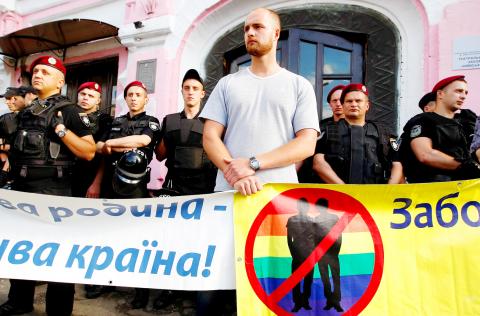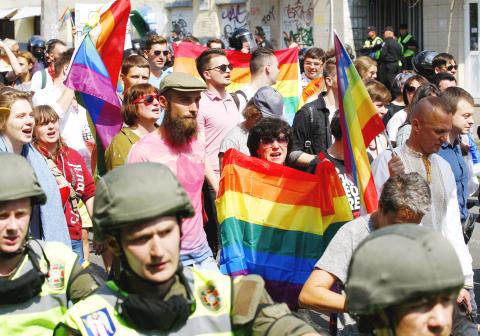Staring at the Berlin Wall mural of Soviet President Leonid Brezhnev kissing East German leader Erich Honecker on the mouth, Yevhenii Kalashnyk knew it was time to come out as gay.
The 20-year-old Ukrainian kissed a friend in front of the graffiti painting in September and posted the photo on Instagram. The decision changed his life.
“I was emotionally full,” he says.

photo: EPA
He said he had only kissed another man for the first time a few months earlier and had arrived in the German capital about 60 days into his first trip to western Europe where he hoped to find some peace of mind after a difficult period.
For while gay sex has been legal in Ukraine since 1991, it remains socially taboo with lesbian, gay, bisexual and transgender (LGBT) people facing stigma, discrimination and sometimes violent attacks, rights groups say.
Ukrainian authorities have increased their support for gay rights since a pro-Western government took power following the Maidan protests in 2014 and in 2015 passed a law banning workplace discrimination against the LGBT community.

photo: EPA
But critics say homophobic attitudes remain widespread. The country scored 19 out of 100 points in a 2016 survey by EU-funded Rainbow Europe ranking LGBT people’s rights in Europe.
Shortly after posting the kiss photo, Kalashnyk received a call from his mother.
“She asked: ‘Are you gay?’ I said ‘yes’ ... Then she started saying very bad things,” he said, adding that his father also threatened him.
SAFE HOUSE
Too afraid to go home to Nikopol, Kalashnyk headed to Kiev when he returned to Ukraine about a month later where he found accommodation with Insight, a local gay rights group.
The organization runs Ukraine’s first and only LGBT shelter — a four-room flat, with bunk beds, a kitchen and communal area, in an old apartment block outside Kiev’s city center.
Up to eight guests at a time can receive food, clothing, medicines, a travel card, as well as legal and psychological help, and can stay up to three months, extendable on an ad hoc basis, Insight says.
“It’s a great opportunity for people to adapt and start a new life. You don’t have to worry about finding work without knowing where to sleep,” said Pavel, a 48-year-old resident from Donetsk, who declined to give his real name.
The facility was launched in June 2014 to help LGBT people fleeing the conflict in the country’s east but has since opened its doors to those from other regions.
More than 10,000 people have been killed and 1.6 million forced from their homes since pro-Russian separatists in the regions of Luhansk and Donetsk rebelled against Kiev’s pro-western government in 2014.
Members of the LGBT community were also affected by the violence with many losing their jobs, having their houses damaged or suffered homophobic attacks amid the upheaval, said Olga Olshanskaya, the Insight shelter coordinator.
She said transgender people were particularly vulnerable to abuse as they had to show ID documents that did not reflect their appearance or sex at checkpoints in conflict-hit areas.
“No one wants to leave their home, but (for many) coming to Kiev was the only hope,” said Olshanskaya in a room adorned by rainbow flags at Insight’s headquarters in central Kiev.
Oksana, a 35-year-old transgender woman from Donetsk, said a militiaman manning a checkpoint pointed a gun at her head because of her looks weeks before she left for Kiev in 2014.
She had started undergoing hormone treatment two years earlier after another weapon — a hunting rifle she held against her head — misfired in a failed suicide attempt. Until then she had kept her sexuality quiet, fearing the wrath of her family.
“I was born with all the right organs, two legs, two feet but ... not in the right body,” she said. “To live life as some else is very difficult.”
Oksana, who preferred not to use her full name, spent just over a month at the Insight shelter in Kiev, long enough to find work at a law firm, and has since founded an advocacy group for transgender rights called T-ema.
GAY PRIDE AND PREJUDICE
But life in Kiev can also be difficult.
Kalashnyk said he sometimes suffers verbal abuse and always carries pepper spray to fight off potential assailants.
In 2015 several dozen protesters attacked a gay pride march, throwing flares and clashing with police.
In June of last year, the same event went ahead largely without incident under heavy security following threats from ultra-nationalist groups supporting what they say are traditional Ukrainian values.
Pavel, who works in the pharmaceutical sector, decided against attending the rally in case colleagues recognized him.
“It could have been the end of my career,” he said.
Some supporters of LGBT rights see progress in Ukraine as symptomatic of the country’s closer integration with the European Union and rejecting its ties with neighboring Russia.
But change is happening too slowly for Kalashnyk.
“I don’t see how I can realize myself here. I don’t see my future in Ukraine,” he said.

The canonical shot of an East Asian city is a night skyline studded with towering apartment and office buildings, bright with neon and plastic signage, a landscape of energy and modernity. Another classic image is the same city seen from above, in which identical apartment towers march across the city, spilling out over nearby geography, like stylized soldiers colonizing new territory in a board game. Densely populated dynamic conurbations of money, technological innovation and convenience, it is hard to see the cities of East Asia as what they truly are: necropolises. Why is this? The East Asian development model, with

June 16 to June 22 The following flyer appeared on the streets of Hsinchu on June 12, 1895: “Taipei has already fallen to the Japanese barbarians, who have brought great misery to our land and people. We heard that the Japanese occupiers will tax our gardens, our houses, our bodies, and even our chickens, dogs, cows and pigs. They wear their hair wild, carve their teeth, tattoo their foreheads, wear strange clothes and speak a strange language. How can we be ruled by such people?” Posted by civilian militia leader Wu Tang-hsing (吳湯興), it was a call to arms to retake

Desperate dads meet in car parks to exchange packets; exhausted parents slip it into their kids’ drinks; families wait months for prescriptions buy it “off label.” But is it worth the risk? “The first time I gave him a gummy, I thought, ‘Oh my God, have I killed him?’ He just passed out in front of the TV. That never happens.” Jen remembers giving her son, David, six, melatonin to help him sleep. She got them from a friend, a pediatrician who gave them to her own child. “It was sort of hilarious. She had half a tub of gummies,

The wide-screen spectacle of Formula One gets a gleaming, rip-roaring workout in Joseph Kosinski’s F1, a fine-tuned machine of a movie that, in its most riveting racing scenes, approaches a kind of high-speed splendor. Kosinski, who last endeavored to put moviegoers in the seat of a fighter jet in Top Gun: Maverick, has moved to the open cockpits of Formula One with much the same affection, if not outright need, for speed. A lot of the same team is back. Jerry Bruckheimer produces. Ehren Kruger, a co-writer on Maverick, takes sole credit here. Hans Zimmer, a co-composer previously, supplies the thumping